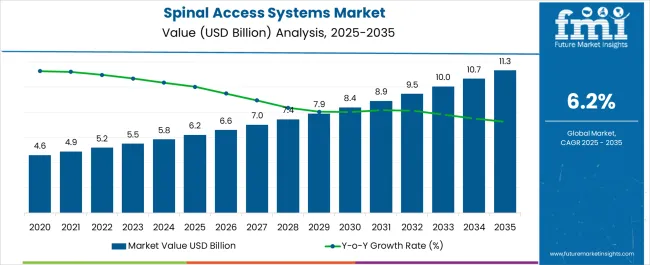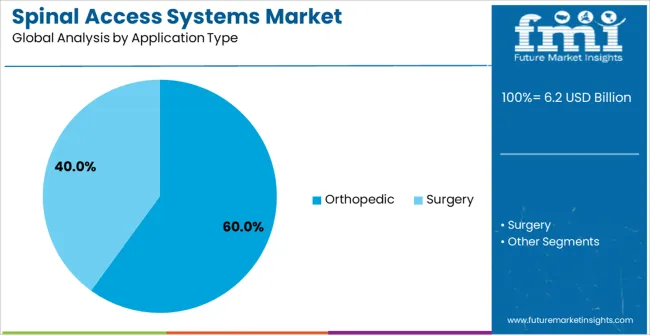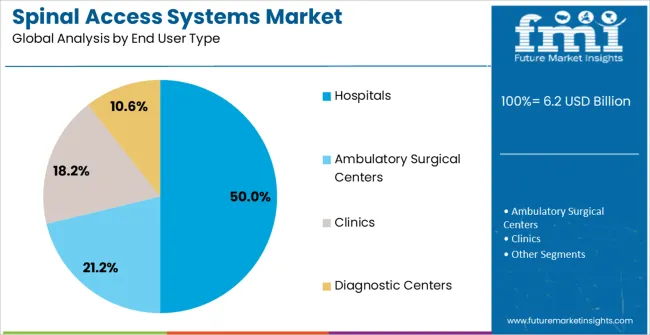The Spinal Access Systems Market is estimated to be valued at USD 6.2 billion in 2025 and is projected to reach USD 11.3 billion by 2035, registering a compound annual growth rate (CAGR) of 6.2% over the forecast period.

| Metric | Value |
|---|---|
| Spinal Access Systems Market Estimated Value in (2025 E) | USD 6.2 billion |
| Spinal Access Systems Market Forecast Value in (2035 F) | USD 11.3 billion |
| Forecast CAGR (2025 to 2035) | 6.2% |
The Spinal Access Systems market is witnessing significant growth driven by the increasing prevalence of spinal disorders and the rising demand for minimally invasive spinal surgeries. The market outlook is shaped by ongoing advancements in surgical techniques and instrumentation, which improve procedural precision and patient outcomes. Investments in healthcare infrastructure and the expansion of specialized spine care centers are contributing to the adoption of advanced spinal access systems.
Technological innovations, such as enhanced visualization, ergonomically designed instruments, and integration with navigation systems, are further supporting market expansion. The growing awareness among patients regarding early intervention and the benefits of minimally invasive procedures is encouraging the uptake of spinal access systems.
Additionally, the rising number of orthopedic and neurosurgical procedures globally, coupled with an aging population susceptible to spinal conditions, is expected to sustain demand As healthcare providers focus on improving surgical efficiency and reducing recovery times, the market for spinal access systems is projected to continue its upward trajectory across both developed and emerging regions.
The spinal access systems market is segmented by product type, application type, end user type, and geographic regions. By product type, spinal access systems market is divided into Retractor Systems, Midline Retractor Systems, Anterior Retractor Systems, Pedicle Based Retractor Systems, and Accessories And Consumables. In terms of application type, spinal access systems market is classified into Orthopedic and Surgery. Based on end user type, spinal access systems market is segmented into Hospitals, Ambulatory Surgical Centers, Clinics, and Diagnostic Centers. Regionally, the spinal access systems industry is classified into North America, Latin America, Western Europe, Eastern Europe, Balkan & Baltic Countries, Russia & Belarus, Central Asia, East Asia, South Asia & Pacific, and the Middle East & Africa.

The retractor systems segment is projected to hold 35.00% of the Spinal Access Systems market revenue share in 2025, establishing it as the leading product type. The segment growth is driven by the critical role of retractors in providing optimal surgical access and visibility, which enhances procedural accuracy and reduces operative risks.
Retractor systems are highly preferred for minimally invasive spinal surgeries due to their ergonomic designs and adaptability to different surgical approaches. The segment has benefited from continuous innovations in materials and instrument design, which improve precision, reduce tissue trauma, and enhance patient outcomes.
High demand for safe and efficient surgical tools in complex spinal procedures has reinforced the adoption of retractor systems The segment’s prominence is further supported by increasing investments in surgical infrastructure, growing awareness among surgeons about advanced instrumentation, and the need for equipment that supports faster recovery and shorter hospital stays.

The orthopedic application segment is expected to capture 60.00% of the Spinal Access Systems market revenue share in 2025, positioning it as the leading application. The growth of this segment is influenced by the rising incidence of musculoskeletal disorders, degenerative spinal conditions, and trauma-related spinal injuries that require specialized surgical interventions.
Spinal access systems have become essential in orthopedic procedures for enabling minimally invasive surgeries, improving precision, and reducing complications. The increasing adoption of image-guided navigation and advanced instrumentation has enhanced the efficiency and reliability of orthopedic spinal surgeries, driving demand in this segment.
Additionally, awareness campaigns and educational initiatives among surgeons regarding innovative spinal access technologies have further propelled adoption As orthopedic procedures continue to rise globally, driven by aging populations and active lifestyles, the orthopedic segment is expected to maintain its dominance in market revenue.

The hospitals end user segment is anticipated to account for 50.00% of the Spinal Access Systems market revenue in 2025, making it the leading end-use segment. The segment’s growth is fueled by the increasing number of spinal surgeries performed in hospital settings due to their advanced infrastructure, availability of specialized surgical teams, and capacity to manage complex procedures.
Hospitals benefit from adopting spinal access systems that improve procedural accuracy, reduce operative time, and enhance patient recovery. The integration of advanced surgical technologies, including navigation and visualization tools, has strengthened the reliance on hospitals as primary end users.
Moreover, the focus on improving surgical outcomes, minimizing complications, and offering high-quality patient care has encouraged hospitals to invest in state-of-the-art spinal access systems The combination of technological advancements, rising procedure volumes, and hospital capabilities continues to drive the dominance of this segment in the market.
A spinal access system market is anticipated to witness significant growth over the forecast period. The market for spinal access systems is categorized based on the types of technology and products. Based on technology, the spinal access systems market can be further subdivided into non-fusion, spinal fusion and fixation technology, spinal decompression technology, vertebral compression technology, and others.
The products segment of the spinal access systems market can further be subdivided into cervical fusion devices, thoracic fusion, spine bone stimulators, dynamic stabilization, vertebral compression fracture devices, and spine biologics.
Generally, spinal fusion technologies are most preferred and are being used for the treatment of spinal disorders including herniated discs and others. However, in recent times the spinal access systems market is witnessing a drift towards nonfusion technologies so as to restore spinal stability with spine mobility.
On the contrary, in some cases, spinal access systems are associated with loss of motion and deterioration of adjacent vertebral levels. Thus, due to significant issues hooked with spinal access systems, most of the manufacturers are working on motion preservation technologies including motion nucleus disc replacement, dynamic stabilization, and others

| Country | CAGR |
|---|---|
| China | 8.4% |
| India | 7.8% |
| Germany | 7.1% |
| Brazil | 6.5% |
| USA | 5.9% |
| UK | 5.3% |
| Japan | 4.7% |
The Spinal Access Systems Market is expected to register a CAGR of 6.2% during the forecast period, exhibiting varied country level momentum. China leads with the highest CAGR of 8.4%, followed by India at 7.8%. Developed markets such as Germany, France, and the UK continue to expand steadily, while the USA is likely to grow at consistent rates. Japan posts the lowest CAGR at 4.7%, yet still underscores a broadly positive trajectory for the global Spinal Access Systems Market.
In 2024, Germany held a dominant revenue in the Western Europe market and is expected to grow with a CAGR of 7.1%. The USA Spinal Access Systems Market is estimated to be valued at USD 2.1 billion in 2025 and is anticipated to reach a valuation of USD 2.1 billion by 2035. Sales are projected to rise at a CAGR of 0.0% over the forecast period between 2025 and 2035. While Japan and South Korea markets are estimated to be valued at USD 325.4 million and USD 158.6 million respectively in 2025.

| Item | Value |
|---|---|
| Quantitative Units | USD 6.2 Billion |
| Product Type | Retractor Systems, Midline Retractor Systems, Anterior Retractor Systems, Pedicle Based Retractor Systems, and Accessories And Consumables |
| Application Type | Orthopedic and Surgery |
| End User Type | Hospitals, Ambulatory Surgical Centers, Clinics, and Diagnostic Centers |
| Regions Covered | North America, Europe, Asia-Pacific, Latin America, Middle East & Africa |
| Country Covered | United States, Canada, Germany, France, United Kingdom, China, Japan, India, Brazil, South Africa |
| Key Companies Profiled | Johnson & Johnson, Schaerer Medical, Boston Scientific, Stryker, Spine Wave, B. Braun Melsungen, NuVasive, and Globus Medical |
The global spinal access systems market is estimated to be valued at USD 6.2 billion in 2025.
The market size for the spinal access systems market is projected to reach USD 11.3 billion by 2035.
The spinal access systems market is expected to grow at a 6.2% CAGR between 2025 and 2035.
The key product types in spinal access systems market are retractor systems, midline retractor systems, anterior retractor systems, pedicle based retractor systems and accessories and consumables.
In terms of application type, orthopedic segment to command 60.0% share in the spinal access systems market in 2025.






Our Research Products

The "Full Research Suite" delivers actionable market intel, deep dives on markets or technologies, so clients act faster, cut risk, and unlock growth.

The Leaderboard benchmarks and ranks top vendors, classifying them as Established Leaders, Leading Challengers, or Disruptors & Challengers.

Locates where complements amplify value and substitutes erode it, forecasting net impact by horizon

We deliver granular, decision-grade intel: market sizing, 5-year forecasts, pricing, adoption, usage, revenue, and operational KPIs—plus competitor tracking, regulation, and value chains—across 60 countries broadly.

Spot the shifts before they hit your P&L. We track inflection points, adoption curves, pricing moves, and ecosystem plays to show where demand is heading, why it is changing, and what to do next across high-growth markets and disruptive tech

Real-time reads of user behavior. We track shifting priorities, perceptions of today’s and next-gen services, and provider experience, then pace how fast tech moves from trial to adoption, blending buyer, consumer, and channel inputs with social signals (#WhySwitch, #UX).

Partner with our analyst team to build a custom report designed around your business priorities. From analysing market trends to assessing competitors or crafting bespoke datasets, we tailor insights to your needs.
Supplier Intelligence
Discovery & Profiling
Capacity & Footprint
Performance & Risk
Compliance & Governance
Commercial Readiness
Who Supplies Whom
Scorecards & Shortlists
Playbooks & Docs
Category Intelligence
Definition & Scope
Demand & Use Cases
Cost Drivers
Market Structure
Supply Chain Map
Trade & Policy
Operating Norms
Deliverables
Buyer Intelligence
Account Basics
Spend & Scope
Procurement Model
Vendor Requirements
Terms & Policies
Entry Strategy
Pain Points & Triggers
Outputs
Pricing Analysis
Benchmarks
Trends
Should-Cost
Indexation
Landed Cost
Commercial Terms
Deliverables
Brand Analysis
Positioning & Value Prop
Share & Presence
Customer Evidence
Go-to-Market
Digital & Reputation
Compliance & Trust
KPIs & Gaps
Outputs
Full Research Suite comprises of:
Market outlook & trends analysis
Interviews & case studies
Strategic recommendations
Vendor profiles & capabilities analysis
5-year forecasts
8 regions and 60+ country-level data splits
Market segment data splits
12 months of continuous data updates
DELIVERED AS:
PDF EXCEL ONLINE
Spinal Pumps Market Size and Share Forecast Outlook 2025 to 2035
Spinal Injectable Market Size and Share Forecast Outlook 2025 to 2035
Spinal Implants and Devices Market Size and Share Forecast Outlook 2025 to 2035
Spinal Devices Market Size and Share Forecast Outlook 2025 to 2035
Spinal Cord Stimulators Market Growth - Trends & Forecast 2025 to 2035
Spinal Osteosynthesis Units Market Trends – Industry Forecast 2025 to 2035
Spinal Stenosis Market – Growth & Demand 2025 to 2035
The Spinal Fusion Market is segmented by Product, Procedure and End User from 2025 to 2035
Spinal Imaging Market Trends – Growth, Demand & Forecast 2022-2032
Spinal Motion-Preservation Devices Market
Spinal Thoracolumbar Implants Market
China Spinal Fusion Market Analysis - Trends, Demand & Forecast 2025 to 2035
Robotic Spinal Surgery Market
Dynamic Spinal Tethering Systems Market Size and Share Forecast Outlook 2025 to 2035
AI-powered Spinal Surgery Market Size and Share Forecast Outlook 2025 to 2035
Disposable Spinal Instruments Market Analysis - Size, Share, and Forecast 2025 to 2035
Non-Fusion Spinal Devices Market Growth - Trends & Forecast 2025 to 2035
Access Control as a Service Market Size and Share Forecast Outlook 2025 to 2035
Access Control Market Analysis - Size, Share, and Forecast 2025 to 2035
Access Control and Authentication Market Analysis & Forecast by Technology, Component, Application and Region through 2035

Thank you!
You will receive an email from our Business Development Manager. Please be sure to check your SPAM/JUNK folder too.
Chat With
MaRIA